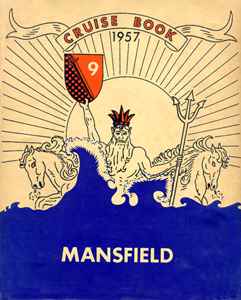 |
 |
DEDICATION This cruise book is respectfully dedicated to the memory of Ralph A. Holt, Jr., SA, USN, who was lost at sea from the U.S.S. Mansfield on 6 May 1957 off the coast of Japan. Ralph Holt was born on 25 September 1939 in Smackover, Arkansas and attended high school at North Little Rock, Arkansas. He enlisted in the U. S. Navy on 28 December 1956 and completed recruit training at the U. S. Naval Training Center, San Diego, California, on 22 March 1957. He reported on board the U.S.S. Mansfield for duty at Guam on 18 April 1957. Ralph Holt is survived by his parents, Mr. and Mrs. Ralph A. Holt, Sr., 1711 West 17th Street, North Little Rock, Arkansas. |
 |
| From the Beginning... SHIP'S HISTORY The U.S.S. MANSFIELD is named in honor of Sergeant Duncan Mansfield, U. S. Marine Corps, who volunteered and took part in an expedition under Lieutenant Stephen Decator, Jr., U. S. Navy, aboard the ketch "Intrepid." The expedition entered Tripoli Harbor on February 16, 1804 and destroyed the former United States Frigate "Philadelphia" which had been captured. The U.S.S. MANSFIELD was built at the Bath Iron Works, Bath, Maine and was commissioned April 14, 1944 at the Boston Navy Yard, Boston, Mass. Immediately following commissioning, the U.S.S. MANSFIELD joined the U. S. Pacific Fleet and in early 1945 took part in offensive operations as a unit of Task Group 38, during the Iwo Jima and Okinawa campaigns. The MANSFIELD is credited with shooting down for enemy aircraft, destroying thirteen mines and rescuing six downed American aviators. In December, 1945 the U.S.S. MANSFIELD along with other elements of Admiral Halsey's Third Fleet was struck by a devastating typhoon five hundred miles east of Manila. After three days of pounding seas and ninety-three knot winds, the Navy counted a loss of seven hundred ninety men, two hundred aircraft and three destroyers. The U.S.S. MANSFIELD weathered the storm but her afterstack was torn away, electrical power failed and the entire topside was severely damaged. In the Summer of 1945, the U.S.S. MANSFIELD, the company with eight other destroyers, skirted the eastern coast of Japan and sank two merchant ships, another probable and damaged a fourth. In August, assisted by another destroyer, the U.S.S. Blue, the U.S.S. MANSFIELD captured the Japanese submarine I-400. On June 25, 1950 the Republic of Korea was in a state of war and the U.S.S. MANSFIELD, then at Sasebo, Japan, was dispatched with Destroyer Squadron Nine to the scene of conflict within forty-eight hours. On December 15, 1950, along with other units of Destroyer of Destroyer Division Ninety One, the U.S.S. MANSFIELD steamed into Inchon Harbor, Korea, in order to locate and destroy Communist shore batteries prior to an amphibious landing. The Communist guns were well camouflaged and the destroyers, led by Commander Destroyer Division Ninety One, steamed into the hostile harbor, waited and dared the enemy to fire. The answer came, thus locating the hidden enemy guns, and the destroyers opened with counter-fire. Due to this heroic action , Destroyer Division Ninety One was awarded the Navy Unit Commendation and the division became known as the "Sitting Duck Division." Following here return to the United States for repairs and rotation of personnel, the U.S.S. MANSFIELD returned to the Korean conflict. During the second tour the ship struck a Communist mine in Wonsan Harbor while engaged in shore bombardment operations. Favored by Divine Providence, the ship was limited to loss of one life, the ship's mascot, a small dog who was listed as "Missing in Action." As a result of the mine explosion, the U.S.S. MANSFIELD now sports a new bow forward of Gun Mount 51. The U.S.. MANSFIELD is an "old timer" in the United States Navy and has battle scars, a name and a record to be proud of. Her purpose as a unit of the fleet is manifold. Specifically, the U.S.S. MANSFIELD is capable of:
|